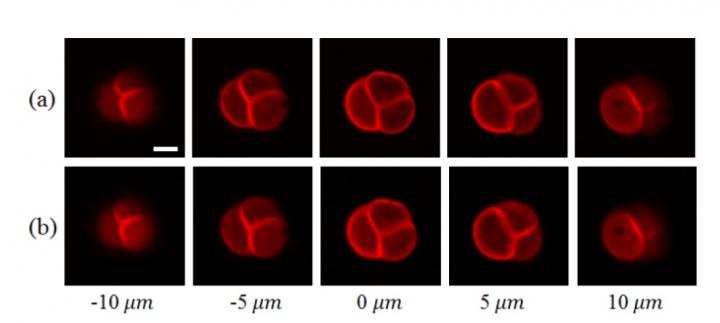To enhance the imaging speed of two-photon microscopy without compromising resolution, researchers from The Chinese University of Hong Kong combined compressive imaging techniques with a multifocus laser illumination method that uses a digital micromirror device (DMD).
The DMD generates 5 to 30 points of focused laser light on randomly selected locations within a specimen. The position and intensity of each point of light are controlled by a binary hologram that is projected onto the device. During each measurement, the DMD reflashes the hologram to change the position of each focus and records the intensity of the two-photon fluorescence with a single-pixel detector.
The speed of the DMD was limited by the rate at which the device could form light patterns. To improve imaging speed, the research team led by professor Shih-Chi Chen combined compressive sensing with the holography-based DMD random-access scanner. Sampling and image compression were performed in a single step and an algorithm was used to fill in any missing information. By exploiting compressive sensing algorithms, the researchers could reconstruct 3D images of a specimen using 70% to 90% fewer exposures than traditional approaches.
The team performed simulations and imaging experiments on different samples to verify the new approach and identify the optimal processing parameters, including the number of laser foci and sampling ratios. The results showed that high-resolution images could be obtained by using a 25% sampling ratio and 5 foci.

The researchers compared two-photon microscopy images of a pollen grain using (a) traditional raster scanning and (b) their new compressive imaging approach.The raster-scanning imaging time was 2.2 seconds while the compressive imaging time required only 0.55 seconds. Courtesy of Shih-Chi Chen/The Chinese University of Hong Kong.
The researchers then tested their computational approach with two-photon imaging experiments. These experiments demonstrated the technique’s ability to produce high-quality 3D images with high imaging speeds from any field of view. For example, the researchers were able to acquire images from five layers in a pollen grain, with each layer measuring 100 × 100 pixels, in just 0.55 seconds. The same images, when acquired with raster scanning, took 2.2 seconds. The 3D fluorescent imaging experiments on pollen samples demonstrated the capabilities of fast 3D imaging on arbitrarily defined planes, including parabolic, inclined, and sinusoidal surfaces.
“We achieved a three-to-five-times enhancement in imaging speed without sacrificing the resolution when imaging arbitrarily selected regions in 3D specimens,” researcher Chenyang Wen said. The new compressive sensing-based DMD imaging platform could find applications in bioimaging and optogenetics for studying fast dynamic events and simultaneously investigating multiple regions of interest in vivo.
The researchers are working to further improve the speed of the reconstruction algorithm and the image quality. They plan to use the DMD platform with other advanced imaging techniques such as wavefront correction.
The research was published in Optics Letters, a publication of OSA, The Optical Society (https://doi.org/10.1364/OL.44.004343).